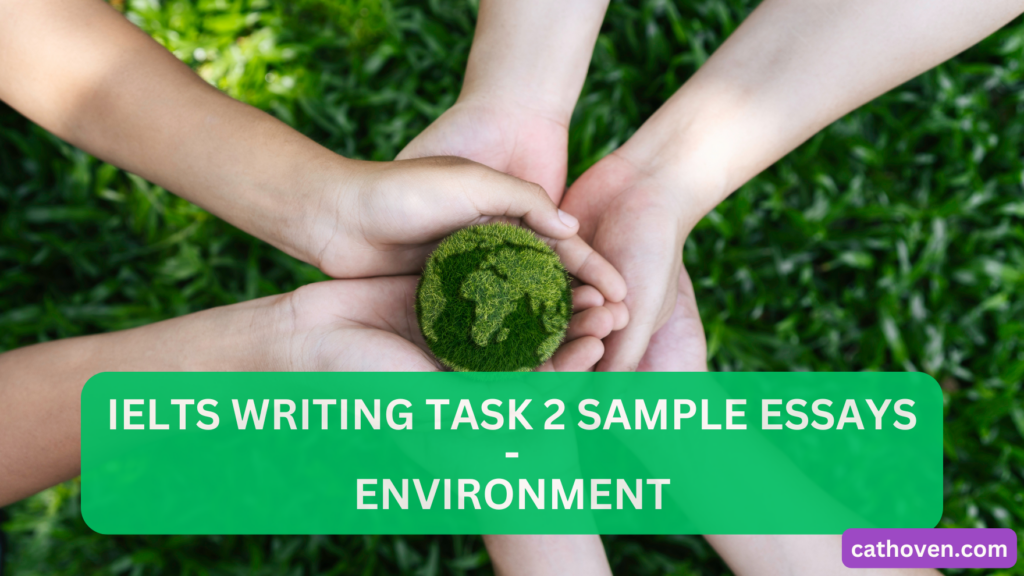IELTS Writing Task 2: Sample Questions and Answers About Environment
- Home
- »
- IELTS Writing Task 2: Sample Questions and Answers by Category
- »
- IELTS Writing Task 2: Sample Questions and Answers on Environment
This page provides a mix of real and authentic environment-related sample questions and answers for IELTS Writing Task 2. Featuring essential vocabulary and concepts, these examples will help you develop strong ideas and arguments for your essays. Use them to enhance your writing skills and confidently tackle a range of topics within the education field.

Example 1 - Does International Cooperation Benefit the Environment or Business More?
Some people think that the main benefit of international cooperation is in the protection of the environment, while others believe that businesses mainly benefit. Discuss both these views and give your own opinion.
See the Model Answer for Band 8
International cooperation has many benefits, but opinions differ on whether it primarily helps the environment or benefits businesses. Both perspectives deserve consideration.
On one hand, some argue that international cooperation is essential for environmental protection. Climate change, pollution, and biodiversity loss are global issues requiring collective action. Agreements like the Paris Climate Accord highlight how countries work together to reduce emissions and promote renewable energy. Without international cooperation, these large-scale efforts might not be possible. This suggests that protecting the environment is a major focus of such collaboration.
On the other hand, others believe that businesses gain more from international cooperation. Trade agreements and economic partnerships open up opportunities for companies to expand into global markets, reduce tariffs, and access resources. For example, multinational corporations benefit greatly from free trade zones and international trade policies. In some cases, businesses might use international cooperation to further their own profit-driven goals rather than focusing on broader concerns like environmental sustainability.
In my opinion, while international cooperation brings significant benefits to both areas, it often leans more toward supporting businesses. Many agreements prioritize economic growth, and environmental initiatives might take a secondary role or face delays. This shows that while the environment benefits, businesses tend to reap the most consistent rewards.
In conclusion, international cooperation benefits both the environment and businesses, but the latter often receives greater advantages.
Example 2 - Causes and Solutions to Environmental Damage
Environmental damage is a problem in most countries. What is the cause of this damage? What should be done about this problem?
See the Model Answer for Band 8
Environmental damage is a significant issue that affects countries worldwide. There are various causes of this damage, and addressing it requires coordinated efforts at both the national and international levels.
One of the main causes of environmental damage is industrialization. Factories and power plants release harmful gases and pollutants into the air, contributing to air pollution and global warming. Additionally, deforestation, driven by the need for land to build infrastructure or for agricultural purposes, results in the destruction of vital ecosystems and loss of biodiversity. Another significant factor is the overuse of natural resources, such as water and fossil fuels, which not only depletes resources but also leads to environmental degradation.
To tackle this problem, governments should enforce stricter environmental regulations on industries to reduce emissions and encourage sustainable practices. Renewable energy sources, such as solar and wind power, should be promoted as alternatives to fossil fuels. Public awareness campaigns are also essential to educate people about the importance of reducing waste, recycling, and conserving resources. On an individual level, people can take action by using public transportation, reducing energy consumption, and supporting environmentally friendly products.
In conclusion, environmental damage is primarily caused by industrialization, deforestation, and resource overuse. To combat this issue, governments must implement stricter regulations, and individuals need to adopt more sustainable lifestyles. Only through combined efforts can we protect the planet for future generations.
Example 3 - Challenges and Actions for Sustainable Living
In many societies, there is a growing emphasis on sustainable living and reducing environmental impact. What are the challenges of adopting a sustainable lifestyle? What practical actions can individuals take to contribute to sustainability?
See the Model Answer for Band 7.5
In many societies, more people are talking about sustainable living. They want to reduce their impact on the environment. However, there are many challenges in adopting a sustainable lifestyle, and practical actions are needed.
One of the biggest challenges is the cost. Many eco-friendly products are more expensive than regular ones. For example, electric cars and solar panels cost a lot of money. This makes it difficult for people to make the change, especially if they have limited budgets. Another problem is convenience. Many people are used to the comfort of single-use plastic, fast fashion, or cheap food. Changing habits can be hard, and people may not be willing to put in the effort needed.
Despite these challenges, there are many practical actions individuals can take. One simple step is reducing waste. People can use reusable bags, bottles, and containers. This cuts down on plastic waste. Another action is choosing products with less packaging or buying in bulk. People can also try to buy local, seasonal foods, which helps reduce the carbon footprint of transportation. Furthermore, walking or using public transport instead of driving can reduce pollution.
In conclusion, while there are challenges to living sustainably, such as cost and convenience, small changes can make a big difference. By being more mindful of our choices, we can all contribute to a more sustainable future.
Example 4 - Causes and Solutions to Environmental Damage from Consumer Goods Production
The increase in the production of consumer goods results in damage to the natural environment.
What are the causes of this?
What can be done to solve this problem?
See the Model Answer for Band 7
The increase in the production of consumer goods has led to more harm to the natural environment. There are several reasons for this, and different actions can be taken to reduce the damage.
One of the main causes is the high demand for products. People are always buying new things, which forces companies to make more goods. To produce these items, companies use many natural resources like water, wood, and metals. This leads to deforestation and pollution. Factories also release harmful gases and waste into the air and rivers, which harms the environment. Another reason is that many goods are made cheaply to satisfy demand. This means that the materials used are often not sustainable, and the goods are not built to last.
To solve this problem, some actions can be taken. Governments should set rules for companies to reduce pollution and waste. They can also encourage companies to use more eco-friendly materials. Consumers can help by buying fewer things and choosing products that last longer. Recycling is another good way to reduce waste. People can also try to buy from companies that care about the environment.
In conclusion, the main cause of environmental damage is the overproduction of goods, driven by high demand. To fix this, both companies and individuals need to make changes. By using resources more wisely and buying less, we can help protect the environment.
Example 5 - Impact of Plastic Pollution on Marine Life
How does plastic pollution affect marine life, and what steps can be taken to reduce it?
See the Model Answer for Band 8
Plastic pollution is a major environmental problem that negatively impacts marine life. It harms marine animals through ingestion and entanglement, and various solutions can help mitigate this issue.
One of the primary ways plastic pollution affects marine life is through ingestion. Marine animals, including fish, sea turtles, and birds, often mistake plastic waste for food. This can lead to internal injuries, malnutrition, or death. For example, sea turtles frequently consume plastic bags, mistaking them for jellyfish. Additionally, plastics break down into microplastics, which are consumed by smaller organisms like plankton. As these microplastics move up the food chain, they pose a threat to larger animals, including humans.
Entanglement is another significant problem. Large plastic debris, such as fishing nets and six-pack rings, can trap marine animals, restricting their movement and causing injury. Many marine species, including seals and whales, are found entangled in plastic, which can lead to long-term harm or even death.
To reduce plastic pollution, several actions can be taken. Governments can implement stricter regulations on plastic production and disposal, such as banning single-use plastics and improving waste management systems. Public awareness campaigns and better recycling programs are also important. On an individual level, people can reduce their plastic consumption by using reusable products and ensuring that plastic waste is properly disposed of.
In conclusion, plastic pollution poses serious threats to marine life. Through government regulations and individual efforts, this issue can be addressed to protect our oceans and the creatures that inhabit them.
Improve Your IELTS Writing with Our Essay Checker Tool

Easily enhance your writing skills with our IELTS Essay Checker! Here’s how it can help:
- Get Instant Feedback: Upload your essay and receive immediate, detailed feedback on your writing.
- Identify Areas for Growth: See where you can improve in grammar, vocabulary, structure, and coherence.
- Track Your Progress: Understand your current score level and watch as your skills grow.
This tool is ideal for refining your practice essays, helping you work towards a higher band score with confidence.

